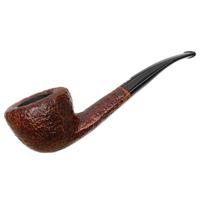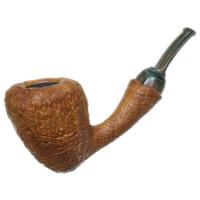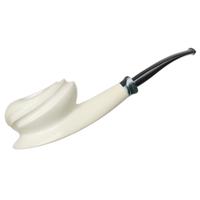Can anyone identify the maker of this meerschaum I purchased without a case?
https://www.flickr.com/photos/41273109@N02/30358821582/in/dateposted-public/
I purchased a figural meerschaum advertised as a “sea captain” from a man who was not sure it was meerschaum and freely expressed his uncertainty. The total bowl height is 4", the gently curved shank is 3½” long. The tobacco chamber is 1¾” deep and ¾” in diameter. The full bent, 3¼” long, deep red plastic(?) stem with a simple circular, unslotted round air hole. About a ¼” of it was broken off at the shank face. I managed to reattach the stem to the shank bone screw by filing and sanding flat the damaged section.
The pipe seems to have been skillfully carved with attention to detail, particularly in carving the feathers and hair strands. It contains areas of deep coloration, deep brown, almost black. These attributes collectively indicate to me a late nineteenth - early twentieth century non-Turkish provenance. The bust rides on a perpendicular triangular base. The shank is attached to the bottom of the bust and top of the base. It is a cylindrical swan neck and is taller than the rim by about an inch. The shank and stem form an elongated S curve. The figure faces an eighth of a turn to the right rather than straight forward. The meerschaum on the cover of Benjamin Rapaport’s A Complete Guide to Collecting Antique Pipes, that is in the Douwe Egbert Pipe Museum, Joure De Witte Os (White Ox, Joure, Friesland, Netherlands) is similarly turned.
The only pipe I could find that comes close to the dimensions and construction is a Negro Zoave wearing a fez. It is in the Pijpenkabinet (Amsterdam Pipe Museum), catalog 16 894. The museum states it was carved by Au Phenix, Lille, France, 1880-1915. Its stem is imitation amber. The bases of other meerschaum bust pipes of the same period rest are much smaller.
The dress of the man depicted on this pipe is almost certainly a mix of features from different eras. He is a elderly Caucasian (middle aged today) of the Georgian era. Although his hair is tied with a ribbon in a queue in the back, it loosely hangs to his shoulders in the front. The carver intended to depict a man engaged in armed combat. The belt buckle on his shoulder is for a baldric, almost certainly for a sword. (He was apparently left handed.) Two epaulettes indicates the rank of captain or higher, or so I mistakenly thought.
After several exchanges on an internet pipe smoking discussion group that pointed me in a specific direction, I’m reasonably certain this figure depicts a sous-officier (warrant officer) of the Marins de la Garde impériale (Imperial Guard Marines) of Napoleon I. A painting, Napoléon inspectant l'escadre de Cherbourg en mai 1811, shows a Marine sous-officier with a single hair queue, epaulettes, high collar open in front and bicorne. Other Imperial Guard Marines in other illustrations and a photograph of historical reenactos are shown sporting moustaches, wearing a single baldric over the left shoulder and a scarf, though neatly tucked into the tunic. Clearly, the carver took artistic license in rendering this figure using features from different Marine rank uniforms in different years. The only detail not part of any Imperial Guard Marine uniform is the feather plume that is British from a later era.
Lesson learned: do all research before publishing and ending up demonstrating to the world what a fool one is.
https://www.flickr.com/photos/41273109@N02/30358821582/in/dateposted-public/
I purchased a figural meerschaum advertised as a “sea captain” from a man who was not sure it was meerschaum and freely expressed his uncertainty. The total bowl height is 4", the gently curved shank is 3½” long. The tobacco chamber is 1¾” deep and ¾” in diameter. The full bent, 3¼” long, deep red plastic(?) stem with a simple circular, unslotted round air hole. About a ¼” of it was broken off at the shank face. I managed to reattach the stem to the shank bone screw by filing and sanding flat the damaged section.
The pipe seems to have been skillfully carved with attention to detail, particularly in carving the feathers and hair strands. It contains areas of deep coloration, deep brown, almost black. These attributes collectively indicate to me a late nineteenth - early twentieth century non-Turkish provenance. The bust rides on a perpendicular triangular base. The shank is attached to the bottom of the bust and top of the base. It is a cylindrical swan neck and is taller than the rim by about an inch. The shank and stem form an elongated S curve. The figure faces an eighth of a turn to the right rather than straight forward. The meerschaum on the cover of Benjamin Rapaport’s A Complete Guide to Collecting Antique Pipes, that is in the Douwe Egbert Pipe Museum, Joure De Witte Os (White Ox, Joure, Friesland, Netherlands) is similarly turned.
The only pipe I could find that comes close to the dimensions and construction is a Negro Zoave wearing a fez. It is in the Pijpenkabinet (Amsterdam Pipe Museum), catalog 16 894. The museum states it was carved by Au Phenix, Lille, France, 1880-1915. Its stem is imitation amber. The bases of other meerschaum bust pipes of the same period rest are much smaller.
The dress of the man depicted on this pipe is almost certainly a mix of features from different eras. He is a elderly Caucasian (middle aged today) of the Georgian era. Although his hair is tied with a ribbon in a queue in the back, it loosely hangs to his shoulders in the front. The carver intended to depict a man engaged in armed combat. The belt buckle on his shoulder is for a baldric, almost certainly for a sword. (He was apparently left handed.) Two epaulettes indicates the rank of captain or higher, or so I mistakenly thought.
After several exchanges on an internet pipe smoking discussion group that pointed me in a specific direction, I’m reasonably certain this figure depicts a sous-officier (warrant officer) of the Marins de la Garde impériale (Imperial Guard Marines) of Napoleon I. A painting, Napoléon inspectant l'escadre de Cherbourg en mai 1811, shows a Marine sous-officier with a single hair queue, epaulettes, high collar open in front and bicorne. Other Imperial Guard Marines in other illustrations and a photograph of historical reenactos are shown sporting moustaches, wearing a single baldric over the left shoulder and a scarf, though neatly tucked into the tunic. Clearly, the carver took artistic license in rendering this figure using features from different Marine rank uniforms in different years. The only detail not part of any Imperial Guard Marine uniform is the feather plume that is British from a later era.
Lesson learned: do all research before publishing and ending up demonstrating to the world what a fool one is.











